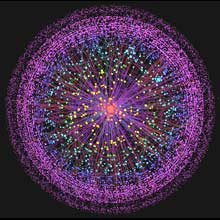June 21, 2007
Mapping the Internet

Peer-to-Peer Networks could stave off Congestion
"The increased use of peer-to-peer communications could improve the overall capacity of the Internet and make it run much more smoothly. That's the conclusion of a novel study mapping the structure of the Internet.
It's the first study to look at how the Internet is organized in terms of function, as well as how it's connected ... The researchers' results depict the Internet as consisting of a dense core of 80 or so critical nodes surrounded by an outer shell of 5,000 sparsely connected, isolated nodes that are very much dependent upon this core. Separating the core from the outer shell are approximately 15,000 peer-connected and self-sufficient nodes.
Take away the core, and an interesting thing happens: about 30 percent of the nodes from the outer shell become completely cut off. But the remaining 70 percent can continue communicating because the middle region has enough peer-connected nodes to bypass the core..." From Mapping the Internet: Routing traffic through peer-to-peer networks could stave off Internet congestion, according to a new study; by Duncan Graham-Rowe, Technology Review.
Posted by jo at June 21, 2007 05:22 PM
